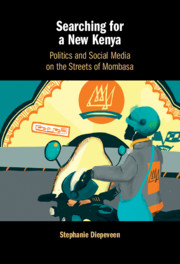Book contents
- Searching for a New Kenya
- Searching for a New Kenya
- Copyright page
- Dedication
- Contents
- Figures
- Acknowledgements
- Note on the Text
- Abbreviations
- Part I Rethinking Publics from Kenya
- Part II Characterising Publics
- Part III Situating Publics in Time and Space
- Part IV The Power of Publics
- Appendix List of Interviewees
- References
- Index
- References
References
Published online by Cambridge University Press: 18 May 2021
- Searching for a New Kenya
- Searching for a New Kenya
- Copyright page
- Dedication
- Contents
- Figures
- Acknowledgements
- Note on the Text
- Abbreviations
- Part I Rethinking Publics from Kenya
- Part II Characterising Publics
- Part III Situating Publics in Time and Space
- Part IV The Power of Publics
- Appendix List of Interviewees
- References
- Index
- References
- Type
- Chapter
- Information
- Searching for a New KenyaPolitics and Social Media on the Streets of Mombasa, pp. 244 - 264Publisher: Cambridge University PressPrint publication year: 2021



